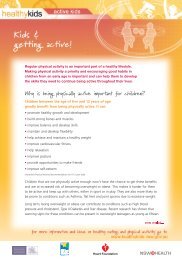The Physical Activity Handbook - Good For Kids
The Physical Activity Handbook - Good For Kids
The Physical Activity Handbook - Good For Kids
Create successful ePaper yourself
Turn your PDF publications into a flip-book with our unique Google optimized e-Paper software.
P.22<br />
Monitoring preschoolers’ progress in fundamental movement skills<br />
Below are three examples of documentation methods you could use to monitor the development<br />
of fundamental movement skills. <strong>The</strong> <strong>Good</strong> for <strong>Kids</strong> program acknowledges that these are only<br />
examples and your service may already have unique and innovative practices which could be<br />
shared with the <strong>Good</strong> for <strong>Kids</strong> program and other services.<br />
See Figure 4 (page P.24) to assist in your observations. It describes the four levels that<br />
children progress through to achieve proficiency in each fundamental movement skill –<br />
pre control, control, utilisation and proficiency. Young children (up to five years old) will<br />
only reach the control level for each fundamental movement skill.<br />
First is a sample of an obstacle course that allows observation of children’s interactions with<br />
equipment and their proficiency in each fundamental movement skill. Using a photocopy of your<br />
chosen obstacle course design (one per child), record how each child moves their body over and/<br />
or through the equipment. This gives an excellent record which can be discussed with the child and<br />
added to their portfolio immediately 37 .<br />
Figure 1: Obstacle course observations 37<br />
I Move We Move, <strong>The</strong> <strong>Physical</strong> Acitivity <strong>Handbook</strong> – Preschoolers, Edition 1 August 2009<br />
AREA HEALTH SERVICE<br />
P.22




